
Thread Lift Treatment in Gurgaon
A thread lift is a minimally invasive cosmetic procedure designed to lift and tighten sagging skin using temporary medical-grade sutures. During the thread lift treatment in Gurgaon, a specialist at a Skin Care Clinic in Gurgaon inserts threads with tiny barbs or cones into the deeper layers of the skin using a thin needle or cannula. These threads anchor into the tissues and are gently pulled to lift the skin. This results in an immediate lifting effect, while the presence of the threads stimulates the body’s natural healing response, promoting collagen production around the threads. This collagen boost helps maintain the lifted appearance even after the threads dissolve, which typically occurs within six months to two years, depending on the type of thread used. The procedure is beneficial because it involves minimal incisions and downtime, allowing patients to resume normal activities the same day. The results are amazing, usually lasting between one to three years, and the procedure is best suited for individuals with mild to moderate sagging. While generally safe, potential complications can include bruising and thread migration, but can be prevented by choosing an experienced doctor. Overall, thread lifts offer a less invasive alternative to traditional facelifts, providing immediate and longer-term skin rejuvenation.
Aging, stress, and daily life take a toll on our skin, making it lose firmness and elasticity over time. If you think your face doesn’t have enough shape, has fine lines, or has skin that is drooping and sagging, especially if you see Jowls below your jawline , you may be looking for something other than surgery. This is where the thread lift treatment comes in handy.
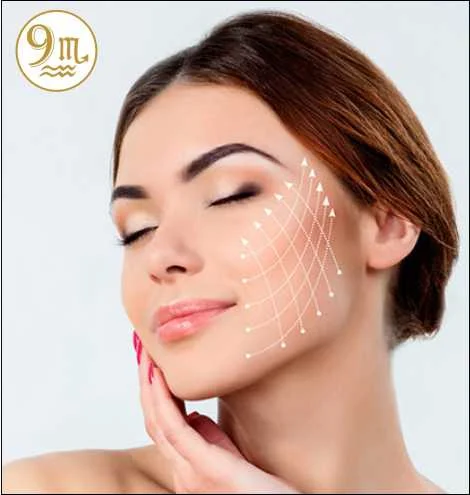
You can get a thread lift instead of surgery. Thread lifts use threads that dissolve under the skin to lift and tighten it. The shape of your face will be fixed quickly and well, and you’ll look naturally young without having to wait.
At 9 Muses Wellness Clinic, Dr. Geeta Grewal delivers advanced, bespoke aesthetic care. Her mastery of minimally invasive facial contouring—especially thread-lift techniques—makes her the go-to expert for clients seeking subtle, natural rejuvenation in Gurgaon.
What is a Thread Lift?
A thread lift is a minimally invasive surgery in which thin, medical-grade threads/ sutures are placed under the skin. These threads lift the skin temporarily, but over time, they also stimulate the body to produce more collagen, which makes the skin thicker and firmer.
A thread lift heals quickly, in less than an hour. Procedure is done for a normal facelift, with serrated threads grip the sagging skin and tissues and gives a mechanical lift and reposition the saggy tissues . Gives immediate lifted & firmer look
People who want to change the shape of their face but don’t want to have major surgery should try thread lift treatment in Gurgaon.
Types of Thread Lift Treatments at 9M Clinic
At 9 M Clinic, we use different thread lift methods that are adapted to work on different parts of the face.
1. Full Face Thread Lift
A full-face thread lift can change the shape of your face, lift sagging cheeks, and remove lines. This can make you look younger all around. After this process, your face looks firmer tighter & lifted .
2. Jawline Thread Lift
A jawline thread lift in Gurgaon is about lifting jowl s and shaping the chin so it looks better. This is a great option for people who feel like their chin has lost its shape as they’ve aged or lost weight.
3. Nose Thread Lift
Want to make your nose stand out more without having surgery? In a nose thread lift, the bridge is raised, and the tip is made more pointy. This changes the shape of the nose. It works just as well if you don’t have surgery.
4. Eye Thread Lift
Eye thread lift in Gurgaon is a good option for people with thin eyebrows or fine lines around their eyes. It makes the eyes look younger and more awake by lifting the corners of the eyes.
5. Face Thread Lift
Lifting parts of the face, like sagging cheeks or nasolabial folds, is what this treatment is all about. It makes the person look younger without surgery.
6. Facial Threading
Threads are usually used to lift and tighten different parts of the face. This is known as face threading. The care given to each person afterface threading in Gurgaon is based on their personal needs.
Why Should You Choose a Thread Lift?
The thread lift is a way to lift your face without surgery. It works quickly and doesn’t take long to heal, unlike a normal facelift, which takes a long time. On the other hand, a thread lift is a quick and safe way to tighten the skin and lift it without changing the way it looks.
Learn more about why a thread lift is useful and what it can do for you here:
1. Lift Right Away
A thread lift is great because it changes the shape of your face immediately and tightens your skin. The threads start pulling the skin up as soon as they are put in and secured. This is very helpful for places like the brows, deep nasolabial folds , lip corner and jowls , where things tend to droop due to gravity. With other treatments, it takes weeks to see results, but a thread lift gives you a younger look right away.
2. Makes collagen for the body
It’s mostly collagen that makes our skin firm, full, and young-looking. We age, and our bodies make less collagen. This makes our skin loose, wrinkled, and more likely to get fine lines. A thread lift does more than just lift the skin over time. It also makes it make more collagen. When the threads are put in, they start the body’s repair process. Collagen and elastin are made in this process. These help the skin stay tight, feel better, and look younger for longer. This will make your skin look better and tighter for months after the threads are absorbed by body which usually takes 8-9 months .
3. Non-surgical and Safe
Some people are afraid to get facelifts because they might leave scars or infections that take a long time to heal. You won’t get big scars or deep cuts after a thread lift. Fine medical-grade threads are carefully put under the skin with a needle as part of the process. It is safe and works well to lift the skin this way. It doesn’t matter in the long run because the body absorbs these threads on its own.
4. Quick and Easy Procedure
How long a thread lift takes -. A thread lift doesn’t take long, so you can easily fit it into your plan. You don’t have to go off work , as the treatment is done in local anaesthetic block local.. It’s so quick and doesn’t hurt that many people even call it a “lunchtime facelift.”
5. Minimal Downtime
When you use a thread lift, you don’t have to take much or any time off. You can get back to your normal life almost right away after a thread lift, but it can take weeks for surgery facelifts to heal. It should go away in a few days if you get redness , swelling, bruises, or other slight side effects. In 24 to 48 hours, a lot of people are ready to go back to work or social events. People who want to get things done without having to change their plans will love it.
6. Natural Results
With a thread lift, you’ll get a lift that doesn’t stand out too much and makes you look natural. A surgery facelift might make you look too tight or weird. By moving free skin back into place without pulling it too tight, thread lifts don’t change the way your face looks or moves. The body slowly makes more collagen over the next few months, which makes the results even better. The skin is smooth, strong and looks clean but not overdone.
7. Long-Lasting Effects
Indeed, thread lifts don’t last forever, but the changes they make last longer than Botox or fills. That depends on your age, skin type, and how you live your life. The effects generally last between 12 and 24 months. Even after the threads are absorbed you’ll still look young because they give your collagen a boost.
How Does a Thread Lift Work?
Some people decide to have the thread lift treatment in Gurgaon done again in a year to prolong the benefits and improve their quality of life.
A thread lift lifts the skin immediately and makes it look younger over time. The process thickens the skin immediately and causes it to produce more collagen, making the skin smoother and stronger over time.
1. Lift Right Away
Under the skin, the threads lift and tighten drooping areas, making the skin look younger and tighter. This instant result helps change the shape of the face, lifts sagging areas, and improves the appearance of the brows, jawline, and cheeks.
2. Making the skin firmer over time
The threads will make the body make more collagen over the next few months. This will make the skin naturally thicker and more flexible. Even after the threads are absorbed the new collagen will still make the skin stronger and tighter, which will make it look smoother and younger.
How to Lift with Thread Step by Step?
Step 1: Clean the area and numb it.
A local sedative is applied to the area that needs work to make the person comfortable during the process.
Step 2: Thread insertion
Very thin PDO (Polydioxanone), PLLA (poly-L-lactic acid), or PCL threads are placed just under the skin with a tiny blunt cannula or needle
Step 3: Lifting and Adjustment
Once in place, the threads are slowly strengthened and changed to move the shape of the face and lift loose skin.
Step 4: Completion
Putting it all together right away, the skin looks better: stronger, smoother, and brighter.
Though it is a little invasive, the whole process only takes thirty to sixty minutes and leaves no stitches or scars behind.
After some time, the threads are absorbed naturally. This makes the skin stronger, tighter, and younger-looking because it produces more collagen. The best way to make your skin look fresh without surgery is to get a thread lift. There are two ways to do this.
Who Is a Good Candidate for a Thread Lift?
- Want to make your face look better without having surgery?
- Would like a quick process with little downtime
- Would you like to change the way your face , lips, nose, or cheeks jowl’s look?
- Want to feel better without using drugs?
- Getting checked out at the 9M Clinic will help you decide if this treatment is right for you.
- Why should you go to 9M Clinic for your thread lift?
At 9M Clinic, our goal is to provide safe, helpful, and top-notch thread lift services that produce natural-looking results. Our skilled team ensures that each treatment is tailored to each patient’s needs.
Why Choose 9M Clinic for Your Thread Lift?
They are experts in their areas and have years of experience –
1. Expert Specialists decades of Years of Experience
Our center’s doctors and cosmetic professionals have extensive experience and know how to use the most up-to-date treatments for skin problems and slowing down the ageing process. Our experts are trained in the newest thread lift techniques to ensure that our patients get the best, safest care possible. Our experts work with you one-on-one to enhance your natural beauty because we know that every face is different.
2. Advanced and FDA-Approved Techniques
At 9M Clinic, they only use FDA-approved PDO, PLLA, and PCL threads know that these threads are safe, work well, and last a long time. The high-quality threads lift your skin right away and help your body make collagen over time. This means that your skin stays firm and young even after the threads fall off. We use cutting-edge tools and methods to make sure the process is as easy as possible while still getting the job done well.
3. Customized Treatments for Every Patient
We make sure that each thread lift is special for you by looking at your skin type, face shape, and how you want to look. You can get a chin lift, cheek lift, nose thread lift in Gurgaon, or a full-face makeover. We make a treatment plan just for you. The people who work here look at your face, listen to your concerns, and tell you how to get the best natural, balanced results.
4. Affordable and Transparent Pricing
We believe that everyone should be able to get great beauty work done. For this reason, all of our thread lift prices are fair and easy to understand. While getting great results is still our main goal, we also work hard to keep our prices low without lowering the quality of our work. We leave no doubt about how much the service you need will cost by breaking it down for you in the meeting.
5. Minimal Downtime and Quick Recovery
You can go back to your normal life the next day after a thread lift at 9M Clinic. A regular facelift takes weeks to heal. Our skilled doctors take great care during the process to make sure there is little to no pain or other issues. We also give you full care instructions after the procedure to help you get better quickly and get the best results.
6. Patient-Centered Care and Satisfaction
We care most about your happiness and comfort. From the time you walk into our office, we promise that everything will go well and there will be no stress. There is no one here who will skip any steps or hurry through the process. They’ll give you time to ask any questions you have. We help our people set goals they can reach and tell them the truth. You can be sure of your results and be happy with them when you leave our centre.
The best thread lift treatment in Gurgaon is available at 9M Clinic, where skill, technology, and one-on-one care work together. Whether you want a small lift or a full-face makeover, we can help you look naturally young and fresh.
Book your appointment right now!
The best way to lift your face without surgery is to get a thread lift treatment in Gurgaon at 9M Clinic. It works well, is safe, and doesn’t hurt. Call us right away to set up a meeting and begin the process of looking better and younger.
Comparison of Thread Lift Vs Ultherapy Vs Thermage
| Feature | Thread Lift | Ultherapy | Thermage |
| Immediate Results | Instant lifting effect | Takes 3-6 months for full results | Takes 2-6 months for full results |
| Targeted Sagging Correction | Best for midface, jawline, and brow lifting, jowl correction | Best for rejuvenation | Best for rejuvenation |
| Downtime | Mild bruising/swelling (3-7 days) | Minimal redness, mild tenderness | Minimal swelling, mild tingling |
| Customizability | Precise, localized lifting with adjustable thread placement | Fixed ultrasound treatment areas | Fixed radiofrequency application |
| Affordability | More cost-effective | Higher cost | Moderate to high cost |
Natural looking results at 9m clinic
Before And After
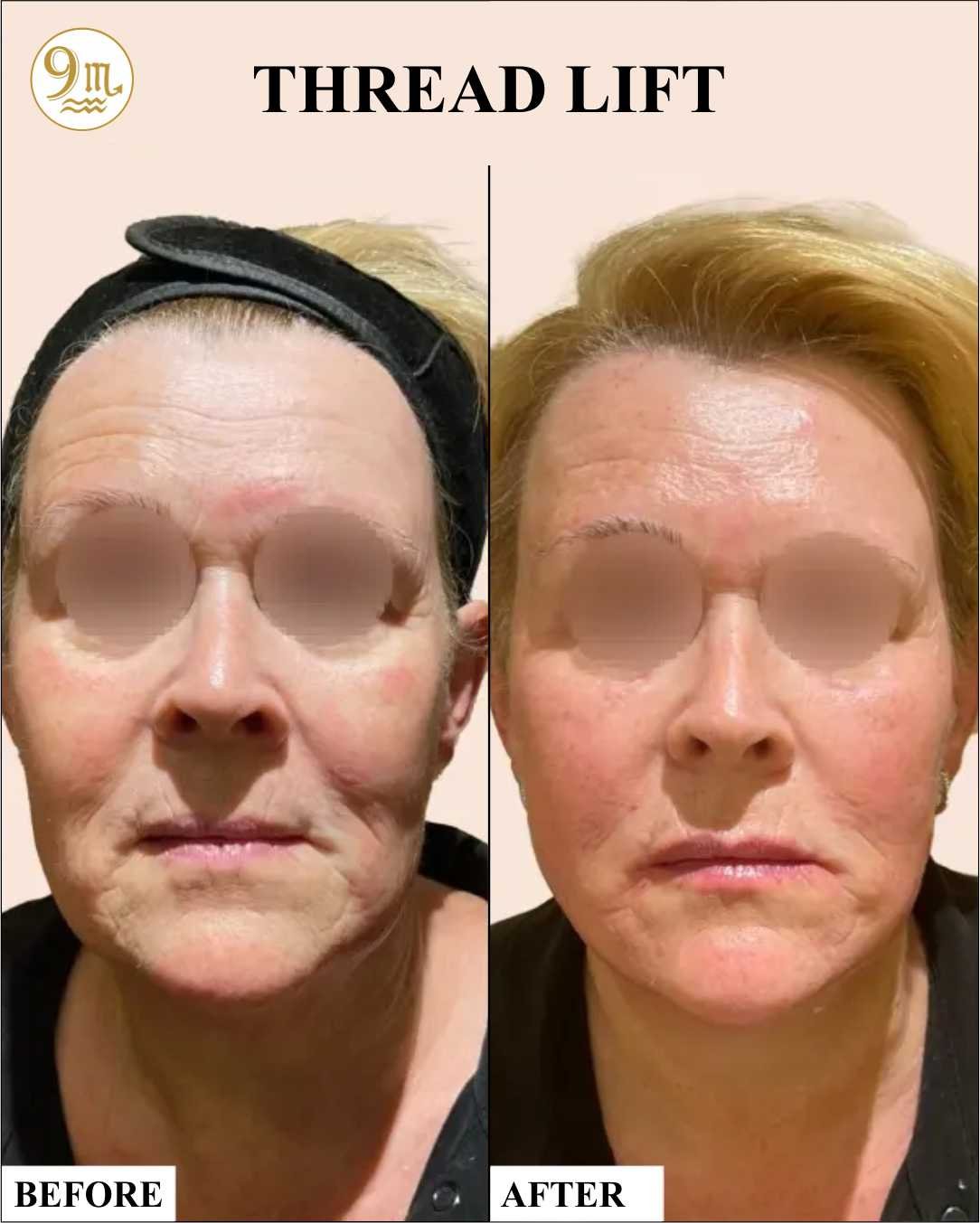
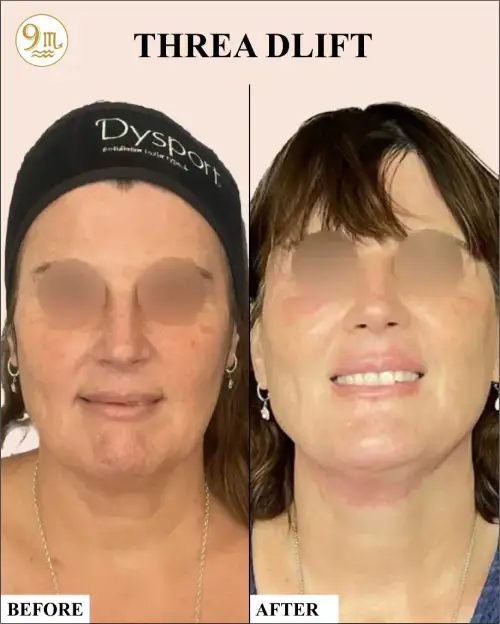

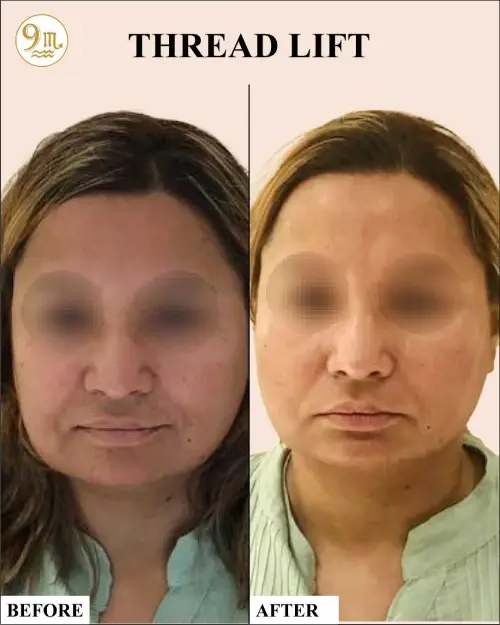
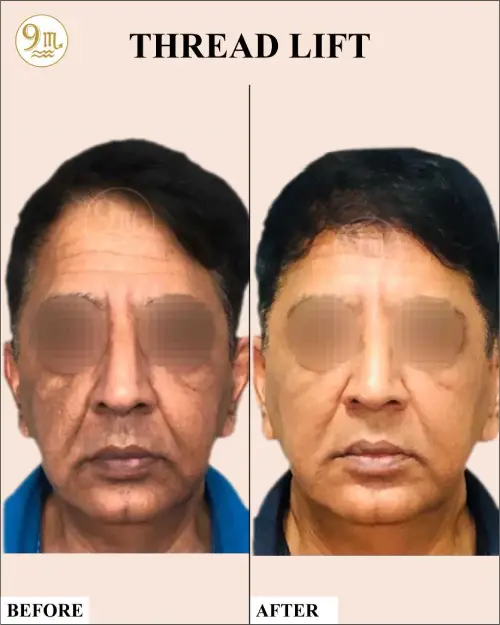
Frequently Asked Questions
In contrast, a traditional facelift is a more invasive surgical procedure typically performed under local or general anesthesia. It involves making significant incisions to remove excess skin and tighten the underlying tissues. This method usually requires a longer recovery period, often several weeks, and carries higher risks of complications such as infection, bleeding, and noticeable scarring.
As we age, not only does our skin lose elasticity, but our facial muscles and fat pads also undergo changes. Even though a traditional facelift can address these issues, it is not a permanent solution. Many patients might need to consider another round of surgery about five years after the initial procedure to maintain the desired results.
However, it is important to highlight that opting for a second surgery is not always advisable. Most surgeons are cautious about performing additional surgeries on the same area due to the extensive internal scarring caused by the initial facelift. This scarring can make redo surgeries or even minimally invasive procedures like thread lifts ineffective. Therefore, careful consideration and consultation with a skilled surgeon are crucial before deciding on any subsequent surgical interventions.
– Avoid strenuous activities and heavy lifting for about a week.
– Refrain from excessive facial movements and sleeping on your side for a few days.
– Keep your head elevated to reduce swelling.
– Avoid touching or massaging the treated area.
– Follow your doctor’s advice on using cold compresses to minimize swelling and bruising. Always follow specific instructions provided by your doctor.
These risks can be minimized by choosing a qualified and experienced practitioner and following post-procedure care instructions diligently.
Potential risks and side effects of thread lifts may include:
- Bruising and swelling
- Temporary numbness or discomfort
- Infection
- Thread migration or visibility
- Asymmetry
- Rarely, injury to deeper structures or nerve damage
- Exterior Thread visibility
When selecting a practitioner for a thread lift, individuals should look for qualifications, experience, and reputation. Specifically, they should consider factors such as:
– Board certification in dermatology or plastic surgery
– Experience performing thread lift procedures
– Before-and-after photos of previous patients
– Positive reviews and testimonials
– Clear communication and personalized treatment plans
The popularity of thread lifts has grown significantly in recent years due to several factors. Patients are increasingly seeking minimally invasive alternatives to traditional facelift surgery, driven by a desire for subtle rejuvenation with minimal downtime. Additionally, advancements in thread technology and techniques have improved the safety and efficacy of the procedure, further contributing to its popularity.
Patients generally report positive experiences with thread lifts, appreciating both the immediate lifting effect and the gradual improvement in skin texture and tone as collagen production increases. Seeing the joy in patients when they look in the mirror and find themselves appearing more youthful is immensely rewarding. Many patients exclaim, “Doc, you brought back my 10-year-younger face,” and some even feel they look up to 15 years younger after this remarkable treatment.
The procedure is often found to be relatively comfortable, with minimal discomfort and significantly less downtime compared to surgical options. The recovery period is short, typically just a few days, allowing patients to quickly return to their daily activities. This convenience, along with the aesthetic benefits, makes thread lifts an attractive choice for those seeking facial rejuvenation without undergoing major surgery.
However, individual experiences can vary. It’s essential for patients to have realistic expectations and understand that, Consulting with a qualified practitioner is crucial to determine if a thread lift is suitable for each individual and to discuss potential outcomes and any risks involved. By doing so, patients can make informed decisions and achieve the best possible results from their thread lift procedure.
Book an appointment